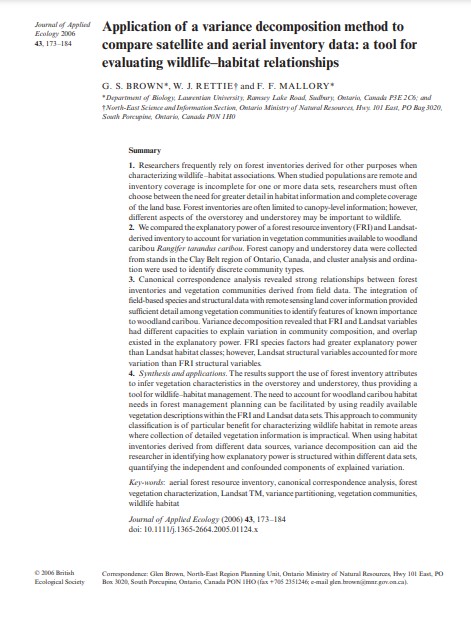Application of a variance decomposition method to compare satellite and aerial inventory data: A tool for evaluating wildlife-habitat relationships
Bosque Modelo:
Lake Abitibi
Temática:
Desarrollo humano
Tipo de documento:
Artículo científico
Resumen
1. Researchers frequently rely on forest inventories derived for other purposes when characterizing wildlife–habitat associations. When studied populations are remote and inventory coverage is incomplete for one or more data sets, researchers must often choose between the need for greater detail in habitat information and complete coverage of the land base. Forest inventories are often limited to canopy-level information; however, different aspects of the overstorey and understorey may be important to wildlife.
2. We compared the explanatory power of a forest resource inventory (FRI) and Landsatderived inventory to account for variation in vegetation communities available to woodland caribou Rangifer tarandus caribou. Forest canopy and understorey data were collected from stands in the Clay Belt region of Ontario, Canada, and cluster analysis and ordination were used to identify discrete community types.
3. Canonical correspondence analysis revealed strong relationships between forest inventories and vegetation communities derived from field data. The integration offield-based species and structural data with remote sensing land cover information provided sufficient detail among vegetation communities to identify features of known importance to woodland caribou. Variance decomposition revealed that FRI and Landsat variables had different capacities to explain variation in community composition, and overlap existed in the explanatory power. FRI species factors had greater explanatory power than Landsat habitat classes; however, Landsat structural variables accounted for more variation than FRI structural variables.
4. Synthesis and applications. The results support the use of forest inventory attributes to infer vegetation characteristics in the overstorey and understorey, thus providing a tool for wildlife–habitat management. The need to account for woodland caribou habitat needs in forest management planning can be facilitated by using readily available vegetation descriptions within the FRI and Landsat data sets. This approach to community classification is of particular benefit for characterizing wildlife habitat in remote areas where collection of detailed vegetation information is impractical. When using habitat inventories derived from different data sources, variance decomposition can aid the researcher in identifying how explanatory power is structured within different data sets, quantifying the independent and confounded components of explained variation.
Información Bibliográfica
Autor:
Brown, GS, WJ Rettie and FF Mallory.
Revista:
Journal of Applied Ecology
Año:
2006
N°:
-
País :
Canadá
Páginas:
173 - 184
Volumen:
43
Idioma:
Ingles
Palabras claves
aerial forest resource inventory, canonical correspondence analysis, forest vegetation characterization, Landsat TM, variance partitioning, vegetation communities, wildlife habitat





